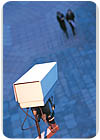
No need to pity the poor time-lapse video recorder. It’s had a great, long run and some applications still allow the old girl to shine.
But there’s no doubt that digital video recorders or DVRs have created a solid niche. And then there’s network video recorders (NVRs) starting to play the “Kill Bill” role. Still the transition deserves a contemplative business decision-making process. Selecting the right equipment in the rapidly changing DVR market can be daunting. You can justify and protect your investment by carefully analyzing a few key factors, according to Gareth McClean, director of R&D, American Dynamics, San Diego.
Storage capabilities
The primary consideration when choosing a DVR is storage capacity. Storage requirements are governed by a number of factors:- What is the quality of the cameras picking up the images?
- What is the video camera resolution?
- How many frames per second will I be capturing?
- What is the compression type?
- How many days worth of videos will I be storing?

Camera quality
For analog cameras, image resolution is determined by the number of horizontal video lines that the camera needs in order to reproduce the desired image. Resolution is often referenced in terms of the Common Image Format (CIF) standard. For IP or digital cameras, resolution is measured in digital pixels.Resolution will depend upon what is recorded. If you simply want to capture an image of a car in a parking lot using an analog camera, for example, one CIF will do. With one CIF, you would be able to determine if there is a vehicle in the camera’s view, but would not be able to capture finer details, such as the license plate number. Two CIF should be used to record more detailed images, such as a license plate number or a person’s face. However, two CIF also requires twice as much disk space so it’s important to take those storage costs into consideration, said Gareth McClean.
There is a common misconception that four CIF is preferable in all environments. However, while four CIF provides twice the image resolution of two CIF; this is only beneficial for static images due to the limitations in the way a TV picture is transmitted and displayed. A TV picture displays two images, which are a fraction of a second between each other. The first frame image consists of all the odd numbered lines while the second image has all the even lines.
It is important to also remember there are many different cameras designed for specific purposes and applications. Overall performance is frequently governed by the quality of the camera attached to it. Using a low quality camera could significantly increase the amount of storage required by the system and possibly defeat the purpose for even trying to record the video.
Frames per second, Image compression
TV pictures display 30 frames per second. However, most security applications don’t require the full 30 frames per second. Typical security cameras record 7.5 frames per second, unless they need to capture subtle details.Storing raw (uncompressed) video would require a tremendous amount of disk space, so vendors employ various compression schemes to minimize storage requirements. There are two primary types of compression: frame based formats, such as M-JPEG, compress individual frames. Change-only formats, such as MPEG, use certain frames as reference frames, recording and transmitting only the information that changes from one frame to the next (such as when a person enters the camera’s field of vision).
Another approach, Active Content Compression (ACC) is a derivative of the MJPEG standard and could be considered a cross between MJPEG and MPEG and provides similar video quality images while using much less disk space.
According to McClean, it’s a good idea to ask potential DVR vendors what storage options are available. DVRs provide a certain amount of internal hard drive space, but generally not enough to store large amounts of video. It’s important to plan for offline storage and retrieval. Some companies make backup copies and store them at an offsite location, while others transmit the data via phone lines to another site.

IP considerations, interoperability
As the industry has slowly moved toward IP-based devices, organizations will have the option to purchase cameras that compress video internally and send the compressed files via IP to storage devices on the network. This reduces installation costs by leveraging the company’s existing computer network infrastructure.Today, surveillance cameras and DVRs can be mixed and matched fairly easily. However, in the IP realm, there are no clear interoperability standards. Just because two devices use MPEG4 does not mean that they will work together. It’s important to confirm that the DVR supports the full range of cameras that you are considering, particularly if you anticipate moving to IP in the future. Additionally, make sure the DVR environment can support networked and non-networked video systems simultaneously.
Then there’s the debate about the merits of DVRs and the convergence of IP camera solutions within the IT domain. While each technology serves the same basic purpose – producing digital video – each has its own pros and cons, according to Andrew Wren, president of Wren, Jefferson City, Mo. His firm provides technology to Wal-Mart, Target and Home Depot, among others.
Wren pointed out that one of the most common problems deploying a successful video solution is improper installation. Analog cameras feeding a DVR, which uses coaxial cabling, can diminish video quality if not properly installed (i.e poor BNC terminations). Additionally, most DVRs are deployed in a central location, requiring “home runs” of cabling, which can make it costly and difficult to add cameras in the future.
While proper installation can also optimize IP cameras, the challenges are fewer and less likely to impact performance, especially if the IP camera uses power-over-Ethernet. There are material and labor savings associated with running CAT 5 versus coax. Also, adding more cameras may not require a home run if a network switch can be used throughout the installation.
One area of concern regarding reliability is that if the DVR encounters a problem with an encoding board, the user could lose the video from all cameras recording on the box. Said Wren, with an IP camera, you are only at risk of losing video from a single camera (realizing that both solutions can fail).
IP solutions allow for more flexibility in deployment and eliminate the issue of fitting the camera count to a pre-determined number. Since each camera produces some level of traffic on the network, implementations that are not properly designed (i.e. a separate video sub-network) can have a negative impact on critical IT infrastructure. Because of the similarity to a traditional network environment, IT managers may have a greater comfort level administering appliances (IP cameras) and application software (video management software) on traditional IT servers and switches, according to Wren.

